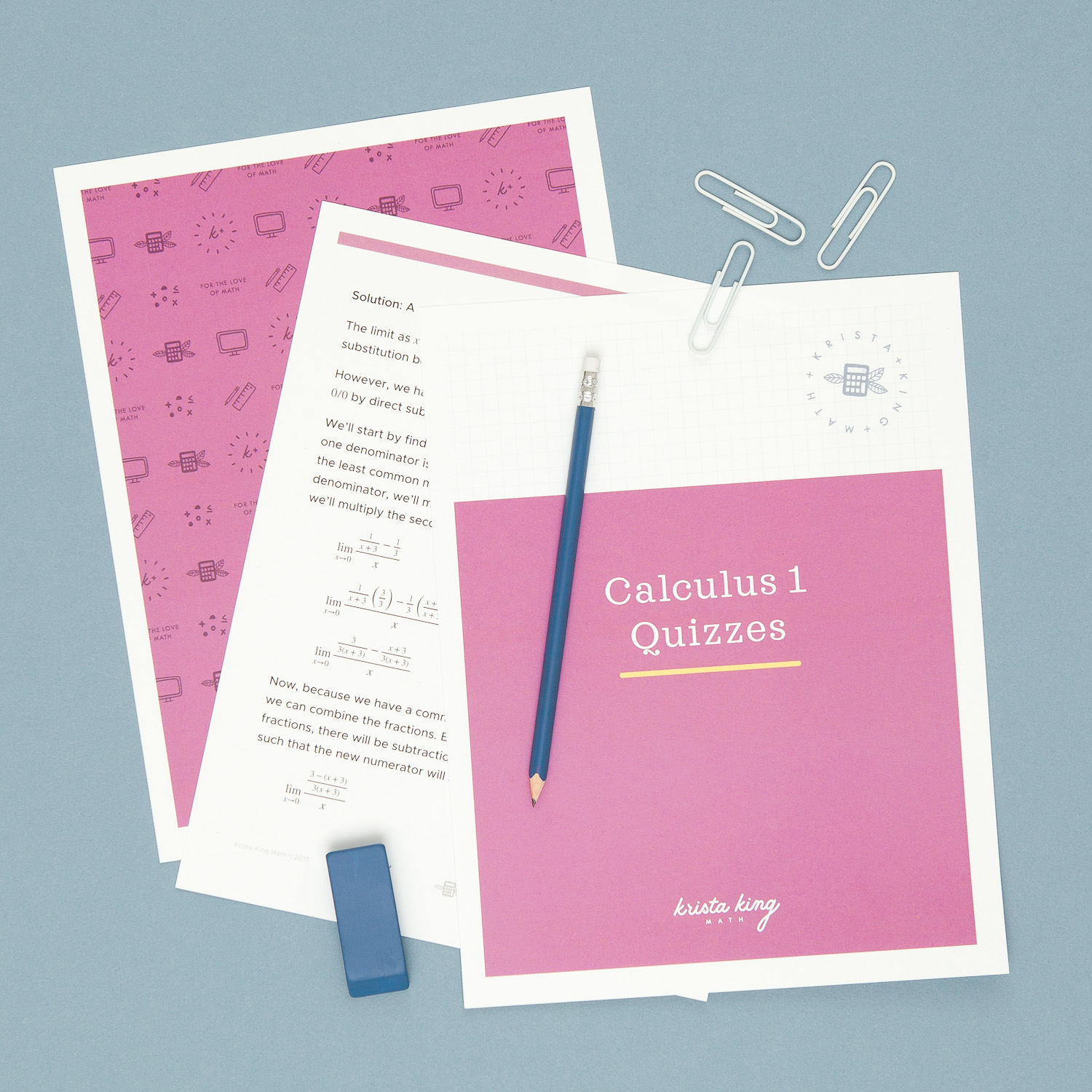Finding extrema (maxima and minima) over a closed interval
What are global and local extrema?
Extrema are points on a function where a maximum or minimum exists. It’s easy to identify the extrema of a function when we look at its graph, because we just look at high points and low points, but we need to be able to use math to calculate their exact coordinates.
Hi! I'm krista.
I create online courses to help you rock your math class. Read more.
Remember that a maximum is a point on our function that is relatively higher than the points on either side of it. A minimum is a point on our function that is relatively lower than the points on either side of it. So when we talk about finding extrema on a closed range, it means we need to consider high points and low points inside the interval, plus the interval’s endpoints.
To find extrema, we need to take the derivative of our function and then set it equal to zero. Then we’ll solve that equation for all possible values of ???x???. The ???x???-values we find will be our critical points. It’s not uncommon to find multiple critical points for one function.
Once we find the critical points, we have to figure out whether they’re maximums or minimums. To figure that out, we can take a point to the left and a point to the right of each critical point and plug them into the derivative.
Maxima: If the point to the left of the critical point produces a positive value when plugged into the derivative, and the point to the right of the critical point produces a negative value when plugged into the derivative, then the critical point is a maximum.
Minima: If the point to the left of the critical point produces a negative value when plugged into the derivative, and the point to the right of the critical point produces a positive value when plugged into the derivative, then the critical point is a minimum.
Finally, we need to characterize each critical point and the endpoints as relative or absolute extrema. We’ll plug each one into the original function to find the corresponding ???y???-value.
Absolute maximum: The critical point associated with the highest ???y???-value we find represents the absolute maximum.
Absolute minimum: The critical point associated with the lowest ???y???-value we find represents the absolute minimum.
Relative extrema: All other critical points are relative maxima and minima.
Finding the extrema (maxima and minima) in a particular interval
Take the course
Want to learn more about Calculus 1? I have a step-by-step course for that. :)
Calculating extrema and classifying them as absolute or relative
Example
Calculate the extrema of the function on the closed interval. Distinguish between absolute and relative extrema.
???y=x^3-2x+1???
on ???[-2,2]???
First we’ll take the derivative of our function, set it equal to ???0???, and solve for ???x???.
???y'=3x^2-2???
???3x^2-2=0???
???x^2=\frac{2}{3}???
???x=\pm\sqrt{\frac{2}{3}}???
This means we have extrema at
???x=-\sqrt{\frac{2}{3}}???
and
???x=\sqrt{\frac{2}{3}}???
and at the endpoints of our interval
???x=-2???
and
???x=2???
Once we find the critical points, we have to figure out whether they’re maximums or minimums. To figure that out, we can take a point to the left and a point to the right of each critical point and plug them into the derivative.
Now we’ll test the extrema inside our interval (not the endpoints yet) to determine whether they are relative maxima or minima.
Let’s look at ???x=-\sqrt{2/3}???. We’ll use ???x=-1??? as the point on its left, and ???x=0??? as the point on its right. Plugging these test points into the derivative, we get
???y'=3x^2-2???
???y'=3(-1)^2-2???
???y'=1???, which is positive
and
???y'=3x^2-2???
???y'=3(0)^2-2???
???y'=-2???, which is negative
Because we see a positive value on the left and a negative value on the right, ???x=-\sqrt{2/3}??? is a relative maximum. It may be the absolute maximum, but we won’t know until we test all of the critical points and endpoints in the original function.
Let’s look at ???x=\sqrt{2/3}???. We’ll use ???x=0??? as the point on its left, and ???x=1??? as the point on its right. Plugging these test points into the derivative, we get
???y'=3x^2-2???
???y'=3(0)^2-2???
???y'=-2???, which is negative
and
???y'=3x^2-2???
???y'=3(1)^2-2???
???y'=1???, which is positive
Because we see a negative value on the left and a positive value on the right, ???x=\sqrt{2/3}??? is a relative minimum. Again, it may be the absolute minimum, but we won’t know until we test all of the critical points and endpoints in the original function.
Now that we’ve tested the critical points, we need to plug each of them and our endpoints into the original function to find out which points are absolute extrema and which are relative extrema.
???y=x^3-2x+1???
For ???x=-\sqrt{2/3}???
???y=\left(-\sqrt{2/3}\right)^3-2\left(-\sqrt{2/3}\right)+1???
???y=2.09???
For ???x=\sqrt{2/3}???
???y=\left(\sqrt{2/3}\right)^3-2\left(\sqrt{2/3}\right)+1???
???y=-0.09???
For ???x=-2???
???y=(-2)^3-2(-2)+1???
???y=-3???
For ???x=2???
???y=(2)^3-2(2)+1???
???y=5???
Based on our results:
???(2,5)??? is the absolute maximum because the highest point is at ???x=2???, the right-hand endpoint of our interval where ???y=5???
???(-2,-3)??? is the absolute minimum because the lowest point is at ???x=-2???, the left-hand endpoint of our interval where ???y=-3???
All other critical points are relative extrema, which means that
???\left(-\sqrt{\frac23},\ 2.09\right)??? is a relative maximum
???\left(\sqrt{\frac23},\ -0.09\right)??? is a relative minimum






